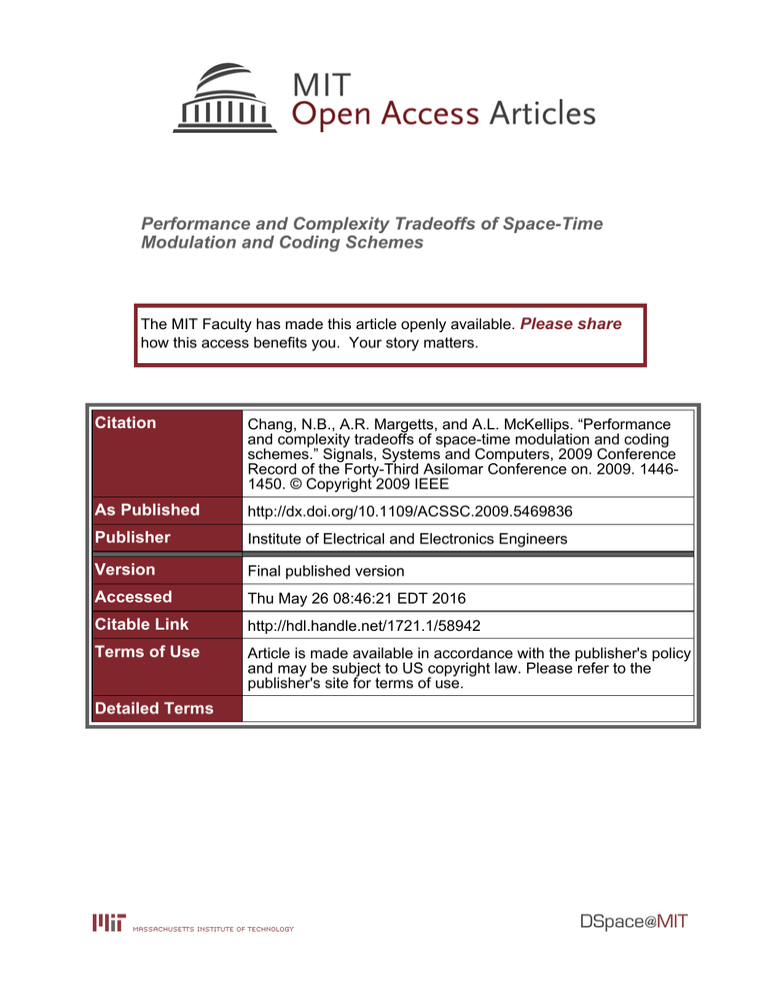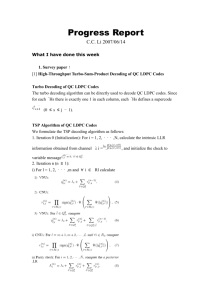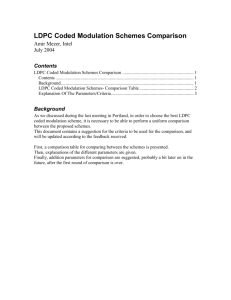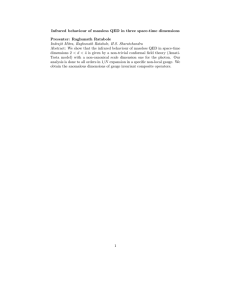Performance and Complexity Tradeoffs of Space-Time Modulation and Coding Schemes Please share
advertisement

Performance and Complexity Tradeoffs of Space-Time
Modulation and Coding Schemes
The MIT Faculty has made this article openly available. Please share
how this access benefits you. Your story matters.
Citation
Chang, N.B., A.R. Margetts, and A.L. McKellips. “Performance
and complexity tradeoffs of space-time modulation and coding
schemes.” Signals, Systems and Computers, 2009 Conference
Record of the Forty-Third Asilomar Conference on. 2009. 14461450. © Copyright 2009 IEEE
As Published
http://dx.doi.org/10.1109/ACSSC.2009.5469836
Publisher
Institute of Electrical and Electronics Engineers
Version
Final published version
Accessed
Thu May 26 08:46:21 EDT 2016
Citable Link
http://hdl.handle.net/1721.1/58942
Terms of Use
Article is made available in accordance with the publisher's policy
and may be subject to US copyright law. Please refer to the
publisher's site for terms of use.
Detailed Terms
Performance and Complexity Tradeoffs of
Space-Time Modulation and Coding Schemes
Nicholas B. Chang, Adam R. Margetts, Andrew L. McKellips
Abstract— Wireless communication using multiple-input
multiple-output (MIMO) systems improves throughput and
enhances reliability for a given total transmit power. Achieving a
higher data rate in MIMO systems requires utilizing an effective
space-time coding and modulation scheme. The appropriate
algorithm to use for a system will depend on parameters such
as the number of transmit/receive antennas, target spectral
efficiency, complexity limitations, channel environment, and
other factors. In this paper, we examine the performance
of various two-transmit and four-transmit space-time coding
schemes under different channel types and target data rates. We
compare the performance of state of the art space-time coding
schemes including direct non-binary LDPC GF(q) modulation,
bit interleaved coded modulation using iterative detection,
and space-time trellis coded modulation. We obtain a tradeoff
between performance and complexity of these various schemes.
I. I NTRODUCTION
Wireless communication using multiple-input multipleoutput (MIMO) schemes dramatically increases system capacity and reliability when information symbols are appropriately
coded and modulated across transmit antennas [1, p. 332].
The main goal of this paper is to examine both the performance and decoding complexity tradeoffs of various spacetime codes for 2x2 and 4x4 MIMO system configurations under various target spectral efficiencies. We primarily consider
three groups of space-time schemes, described in Section III.
Each scheme assumes no channel feedback to the transmitter,
i.e. an uninformed transmitter.
The main contributions of this work are as follows:
• We propose an efficient LDPC GF (q) code which has
low encoding complexity and is later shown to have very
strong performance.
• Using outage probability as our baseline metric, we
compare the performance of various space-time coding
schemes for different target spectral efficiencies, antenna
configurations, and channel models.
• We show empirically for various space-time coding
schemes that the excess SNR (dB), defined for a fixed
* Please direct all correspondence to Nicholas B. Chang, MIT Lincoln
Laboratory, 244 Wood St., Lexington, MA 02420, e-mail: nchang@ll.mit.edu,
phone 781.981.0606, fax 781.981.3905.
The authors are with the Advanced Sensor Techniques Group, MIT Lincoln
Laboratory, Lexington, MA.
This work was sponsored by the Department of Defense under Air
Force contract FA8721-05-C-0002. Opinions, interpretations, conclusions, and
recommendations are those of the authors and are not necessarily endorsed
by the United States Government.
978-1-4244-5827-1/09/$26.00 ©2009 IEEE
•
spectral efficiency as the additional SNR needed for a
given code to achieve the same frame error rate (FER)
performance as the best possible code, decays linearly
as the decoding complexity increases exponentially. This
important relationship demonstrates the amount of extra
computation required to decrease power consumption.
For a fixed target spectral efficiency, we examine how
the complexity per successfully decoded bit (goodbit) decreases with SNR for various space-time coding schemes.
This analysis simultaneously measures the performance
and complexity for different codes as a function of SNR.
II. S YSTEM M ODEL
For narrowband MIMO systems, the coupling between
transmit and receive antennas can be modeled as:
ρ
Hn xn + wn ,
(1)
zn =
nT
where n = 1, 2, . . . , nS (number of space-time symbols), Hn
is the nR × nT (number of receive by number of transmit
antenna) channel matrix containing the complex attenuation
between each transmit and receive antenna over the nth spacetime symbol, xn is an nT × 1 space-time symbol with unit
energy elements, ρn is the average total transmit energy for
the nth space-time symbol, zn is the nR × 1 complex receivearray output, and wn is an nR ×1 vector containing temporally
and spatially white zero-mean complex Gaussian noise, i.e.,
E[wn wn† ] = I, where I is the identity matrix, E[·] is the
expectation operator and ·† denotes the conjugate transpose.
The term ρ can be interpreted as the SNR per receive antenna
for each space-time symbol.
We study performance over a block fading channel model,
in which the channel varies (fades) periodically within a
codeword. Under this model, the channel changes randomly
between fades, and the length of each fade (block length)
is assumed to be constant. The block length is a parameter
that can be tuned to match different environments. Note that
block lengths of 1 and nS correspond to the fast fading and
flat fading (or quasi-static) channel models, respectively. In
this paper, elements of the channel attenuation matrix for
each fading block are modeled as i.i.d. complex circularly
symmetric Gaussian random variables with unit variance.
Additionally, channel realizations are independent between
different codewords (frames). The channel is known only by
the receiver. The FER is the expected rate at which codewords
are incorrectly decoded. In this case, outage probability [1,
1446
Asilomar 2009
p. 366] serves as the lower bound on FER performance for
infinitely long, isotropically transmitted codewords.
III. S YSTEM D ESIGN
In this section, we provide an overview of the coding and
modulation schemes which are compared in this study.
A. Bit Interleaved-Coded Modulation with Iterative Detection
Bit-interleaved coded modulation with iterative detection
(BICM-ID) schemes utilize strong binary error-correcting
codes, including low-density parity-check (LDPC) and turbo
codes, for MIMO Rayleigh fast-fading channels [2], [3], [4]
and for quasi-static channels [5]. Encoded bits are interleaved
and mapped to space-time symbols. Due to the binary code,
BICM-ID schemes must iteratively pass information between
the demodulator and decoder to effectively separate the bits
transmitted over multiple antennas [6] on the same space-time
symbol. In this paper, for best performance we consider fullcomplexity demapping schemes. Lower complexity list-sphere
decoding techniques trade performance with complexity and
are discussed in [6].
B. Direct GF(q) LDPC Modulation
The second set of space-time candidate codes utilizes
LDPC codes over binary field extensions (higher-order fields)
[7], [8], which have been shown to outperform their binary
counterparts [9] in designing a space-time coding scheme. In
[7], a direct space-time GF(256) LDPC modulation scheme
outperformed binary LDPC-encoded bit-interleaved codedmodulation iterative detection (BICM-ID) schemes over a 2×2
fast-fading MIMO channel and in [5], results for quasi-static
channels were provided for single receive antenna systems.
For direct LDPC GF(q), each LDPC code symbol over
GF(q), q = 2m , is directly mapped to L space-time symbols,
where L is a positive integer. The binary representation of
each GF(2m ) code symbol is partitioned into L·nT sets of
m
L·nT -tuples such that each set maps to a single-antenna
constellation point using a Gray-mapping scheme. The mapped
constellation points are then transmitted simultaneously from
the nT transmit antennas over L space-time symbols. For
example, one could map symbols from a GF(256) LDPC
code to a four-transmit antenna system employing a QPSK
constellation at each transmitter.
The receiver generates a set of likelihoods for each spacetime symbol and passes this information to the GF(q) LDPC
code decoder. Bayesian belief networks [10] and graphical decoding techniques can be used to formulate decoders
for LDPC codes and turbo codes. Some simplifications are
possible, but in general the GF(q) decoding complexity per
iteration grows as O(nS q log q). The reader is referred to
[11] for details regarding GF(q) LDPC decoding and reducedcomplexity implementations, and to [7], [8], [12] for more
details on the direct LDPC space-time modulation and coding.
While LDPC GF(q) codes are defined by sparse parity check
matrices, their corresponding generator matrices are generally
not sparse and encoding thus requires a full matrix multiplication. Structured codes have been studied to decrease encoding
complexity for binary LDPC codes [13], but their extension to
higher-order fields and performance in MIMO systems have
not been well-studied. To reduce the encoding complexity, we
form a staircase parity-check matrix via concatenation of two
matrices, [W |V ], where W is a sparse n−k by k matrix while
V is an n−k by n−k matrix described in Figure 1. Note that
Fig. 1.
Right portion of LDPC GF(q) staircase parity check matrices.
V contains two nonzero diagonals, whose coefficients {αj }
and {βj } are nonzero GF (q) elements chosen randomly. If a
codeword has the form [s1 , s2 , · · · , sk , p1 , · · · , pn−k ], where
{sj } are the systematic information symbols and {pj } are the
parity symbols, then multiplying the parity check matrix by
the codeword symbols results in the following equations for
the parity symbols:
p1 =
k
W1,j
j=1
α1
sj
..
.
pi =
k
Wi,j
βi−1
pi−1 +
sj
αi
αi
j=1
..
.
pn−k =
k
Wn−k,j
βn−k−1
pn−k−1 +
sj
αn−k
αn−k
j=1
where Wl,j is the element in the lth row and jth column of
W . Thus, encoding can be implemented by an accumulator
which consists of two steps described in Figure 2: (1) compute
a vector dot product between information symbols and a
normalized row of the sparse matrix W and (2) pass the
multiplication output to an accumulator to compute the parity
symbols.
We use the term staircase LDPC code to describe a code
whose parity check matrices take the form given in Figure 1.
Other LDPC codes with low encoding complexity have also
been recently proposed [12].
1447
Fig. 2.
Accumulator implementation of encoder for staircase LDPC codes. Note that encoding complexity scales linearly with codeword length.
Fig. 3. Throughput vs. SNR per receive antenna at FER of 10% for
various 2 × 2 schemes, each using 6000 space-time symbols, in a flat
fading channel. Theoretical bounds are given by the solid curve and
calculated from pout in (2).
Throughput vs. SNR per receive antenna at FER of 10%
for various 2 × 2 schemes, each using 6000 space-time symbols,
in a block fading channel with the block length fixed at 5 spacetime symbols. Theoretical bounds are given by the solid curve and
calculated from pout in (2).
Fig. 4.
C. Space-Time Trellis Coded (STTC) Modulation
The third group of candidate codes are space-time trellis
codes (STTC) [14], [15] which sacrifice some performance
for lower decoding complexity. STTC simultaneously offer
coding gain with spectral efficiency and full diversity over
fading channels. Powerful space-time trellis codes for QPSK
modulated schemes were derived in [16], [15] for different
number of states. The reader is referred to [14], [16], [15] for
more detailed information on STTC schemes.
IV. R ESULTS
We first present the performance results obtained for the
various signaling schemes described, and then use these results
to study the performance-complexity tradeoffs.
For the direct modulation schemes using GF(q) LDPC
codes, decoding is halted if a maximum of 100 iterations is
reached, if the parity-check equations are satisfied after an
iteration, or if the detected codeword remains unchanged for
10 consecutive iterations. The BICM-ID scheme is allowed to
use up to 10 iterations for passing information between the
demodulator and decoder.
To compare the performances of the proposed space-time
coding schemes to theoretical limits, we first define the average
total transmit energy over all space-time symbols as ρ. Then
the outage probability as a function of ρ is given by [1, p. 367]:
n
S
ρ
†
log2 det I +
Hk Hk < R , (2)
pout (ρ) = P
nT
k=1
A. Performance
The following results demonstrate the performance of the
aforementioned space-time schemes for a wide range of antenna configurations, signaling constellations, and SNR levels.
The channel matrix was perfectly known to the receiver; in
practice, channel estimation errors will impact performance.
where R is the spectral efficiency (b/s/Hz) specified by the
system parameters, and P [·] is the probability measure. Equation (2) was evaluated using Monte Carlo methods.
The performances of the direct LDPC GF(q) schemes, a
BICM-ID scheme [6], and STTC schemes [15] are compared
by measuring the 10% outage throughput vs. SNR in Fig. 3
1448
and Fig. 4. The theoretical bounds, given by the solid curves,
indicate the minimum ρ such that pout (ρ) is 10% for a
given spectral efficiency. In order to achieve various spectral
efficiencies, the following parameters are varied: coding rate,
galois field size, and signal constellation. All schemes are
allowed to use 6000 space-time symbols per frame. Thus, a
scheme achieving throughput of 2/3 b/s/Hz will encode 4000
information bits in a single frame.
For all of the various target spectral efficiencies, the LDPC
GF(256) code performs very well, coming within 0.5 − 1
dB of the theoretical bound. In addition, by simply changing
the constellation size from BPSK up to 16QAM, strong
performance can be achieved by the direct LDPC modulation.
This strong performance over the different spectral efficiencies
is appealing for designing rate-adaptive systems.
The staircase LDPC codes described in Section III-B, which
are denoted as Direct Stair LDPC in the figures, have very similar performance to their more random GF(256) counterparts
for the block fading model but suffer performance degradation
for the flat fading channel in Fig. 3.
The performance of BICM-ID is 1 − 3 dB worse than
direct LDPC modulation for various spectral efficiencies under
both channel models, which can be attributed to the iterative
receiver processing described in [6].
The 64-state QPSK-modulated STTC scheme [16], [15]
indicated in the figure is the best space-time trellis code at
the given rate known to the authors. Deriving strong STTC
codes for an arbitrary spectral efficiency requires an exhaustive
search or rate-adaptive puncturing methods. Its performance
significantly trails direct LDPC modulation and BICM-ID.
The performance is also compared for a 4 × 4 system in
Fig. 5. Again, the direct-modulated LDPC GF(256) scheme
achieves performance close to the achievable-rate bounds. The
plot also includes a 64-state punctured STTC whose throughput matches that of the direct LDPC and BICM schemes, as
well as a strong convolutional code with a constraint length
of 13.
B. Performance Versus Complexity Tradeoff
The various space-time coding and modulation schemes
described in the previous section achieve a wide range of performance levels but require varying degrees of computational
complexity which leads to a performance-complexity tradeoff.
In this section, complexity is measured by the total number
of multiplications, additions, and lookup table operations.
Performance is measured by the excess SNR, which is defined
for a fixed spectral efficiency and target FER as the additional
SNR needed by a code to match the performance of the best
possible code.
Fig. 6 depicts the excess SNR with respect to the achievable
rate and the corresponding number of operations per information bit for some 4x4 schemes under a flat fading channel.
As the excess SNR at target FER 10% approaches 0, the
complexity increases exponentially. For example, to achieve
this target FER one can either use a 64-State STTC or a
Fig. 5. Throughput vs. SNR per receive antenna at FER of 10% for
various 4×4 schemes, each using QPSK constellation for 240 spacetime symbols, under a flat fading channel. The theoretical bound,
given by the solid curve, is calculated from pout in (2).
Plot of excess SNR for 2 × 2 and 4 × 4 systems at
10% outage vs. operations per information bit for space-time trellis
coded modulation, binary LDPC BICM, and direct GF(256) LDPC
modulation.
Fig. 6.
GF(256) LDPC code which requires approximately 100 more
operations per information bit but saves 2 dB SNR.
The LDPC decoding complexity, however, is an SNRdependent random variable because the number of decoding
iterations decreases as the SNR increases. Additionally, FER
also decreases as SNR increases. Fig. 6 thus does not compare
the complexity and performance of codes at the same SNR
level. We thus consider the following metric for each scheme:
βf (ρ)
βf (ρ)
=
,
γf (ρ)
[1 − pf (ρ)]r
(3)
where βf (ρ) is the average number of operations per frame
at SNR ρ, γf (ρ) is the goodput, e.g. average number of
successfully decoded information bits per frame, pf (ρ) is the
frame error rate, and r is the number of information bits
per frame. The metric (3) indicates the complexity required
1449
Fig. 7. Number of operations per goodbit for a 2x2 system in a block fading
environment.
per successfully decoded information bit (goodbit), assuming
packets are retransmitted until successful.
Fig. 7 depicts the performance of three schemes with respect
to (3). The STTC has fixed complexity per decoded frame;
however, at low SNR (i.e., high FER), multiple retransmissions
lead to high complexity per good bit. The LDPC GF(256) and
BICM-ID decoding complexities decrease rapidly as the SNR
increases since fewer decoding iterations are required for successful decoding. At high SNR, the complexity requirements
of all three schemes lie within the same order of magnitude.
Previous works have studied the complexity versus performance tradeoff for specific coding schemes. For example, [17]
studies the relationship between complexity and excess SNR
for binary LDPC codes. Our results, by contrast, compare the
complexity between different schemes.
[4] J. Zheng and B. D. Rao, “LDPC-coded MIMO systems with unknown
block fading channels: Soft MIMO detector design, channel estimation,
and code optimization,” IEEE Trans. on Signal Processing, vol. 54,
pp. 1504–1518, Apr. 2006.
[5] G. Li, I. J. Fair, and W. A. Krzymień, “Low-density parity-check
codes for space-time wireless transmission,” IEEE Trans. on Wireless
Communications, vol. 5, pp. 312–322, Feb. 2006.
[6] B. M. Hochwald and S. ten Brink, “Achieving near-capacity on a
multiple-antenna channel,” IEEE Trans. on Communications, vol. 51,
pp. 389–399, Mar. 2003.
[7] R. Peng and R.-R. Chen, “Design of nonbinary LDPC codes over GF(q)
for multiple-antenna transmission,” Proc. IEEE Military Communication
Conf., pp. 1–7, Oct. 2006.
[8] A. R. Margetts, K. W. Forsyth, and D. W. Bliss, “Direct space-time
GF(q) LDPC modulation,” Proc. Asilomar Conf. on Signals, Systems
and Computers, pp. 1264–1268, Oct. 2006.
[9] M. C. Davey and D. J. MacKay, “Low-density parity check codes over
GF(q),” IEEE Communications Letters, vol. 2, pp. 165–167, Jun. 1998.
[10] R. J. McEliece, D. J. C. MacKay, and J.-F. Cheng, “Turbo decoding as
an instance of Pearl’s belief propagation algorithm,” IEEE Journal on
Selected Areas in Communications, vol. 16, pp. 140–152, Feb. 1998.
[11] H. Song and J. Cruz, “Reduced-complexity decoding of Q-ary LDPC
codes for magnetic recording,” IEEE Trans. on Magnetics, vol. 39,
pp. 1081–1087, Mar. 2003.
[12] R. Peng and R.-R. Chen, “Application of nonbinary LDPC cycle codes
to MIMO channels,” IEEE Trans. on Wireless Communications, vol. 7,
pp. 2020–2026, Jun. 2008.
[13] T. Richardson and R. Urbanke, “Efficient encoding of low-density paritycheck codes,” IEEE Trans. on Information Theory, vol. 47, pp. 638–656,
Feb. 2001.
[14] A. V.Tarokh, N. Seshadri, “Space-time codes for high data rate wireless
communication: Performance criterion and code construction,” IEEE
Transactions on Information Theory, vol. 44, pp. 744–765, Mar 1998.
[15] Z. Chen, B. S. Vucetic, J. Yuan, and K. L. Lo, “Space-time trellis codes
for 4-PSK with three and four transmit antennas in quasi-static flat fading
channels,” IEEE Communications Letters, vol. 6, pp. 67–69, Feb. 2002.
[16] Z. Chen, J. Yuan, and B. S. Vucetic, “Improved space-time trellis coded
modulation scheme on slow Rayleigh fading channels,” Electronics
Letters, vol. 37, pp. 440–441, Mar. 2001.
[17] A. Khandekar, “Graph-based codes and iterative decoding,” PhD Thesis,
California Insitute of Technology, 2002. Pasadena, CA.
V. C ONCLUSION
This work studied the performance and complexity tradeoff
of various space-time coding schemes at different spectral
efficiencies and channel models. Results were obtained for
schemes including direct GF(q) LDPC space-time coding, the
bit interleaved coded modulation (BICM), and space-time trellis coded modulation. It was shown empirically that for various
space-time codes, the excess SNR decreases linearly as the
decoding complexity increases exponentially. Additionally, the
complexity per goodbit was measured for various codes. This
performance measure resulted a comparison in the effective
complexity for different space-time coding schemes at the
same SNR levels.
R EFERENCES
[1] D. Tse and P. Viswanath, Fundamentals of Wireless Communication.
New York: Cambridge University Press, 2005.
[2] S. ten Brink, G. Kramer, and A. Ashikhmin, “Design of low-density
parity-check codes for modulation and detection,” IEEE Trans. on
Communications, vol. 52, pp. 670–678, Apr. 2004.
[3] F. Guo and L. Hanzo, “Low complexity non-binary LDPC and modulation schemes communicating over MIMO channels,” Proc. IEEE
Vehicular Technology Conference, vol. 2, pp. 1294–1298, Sep. 2004.
1450


